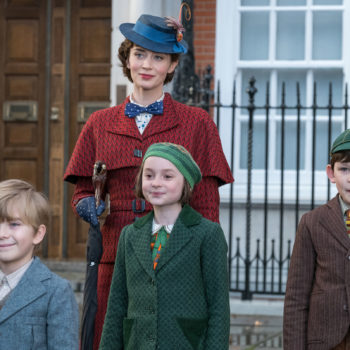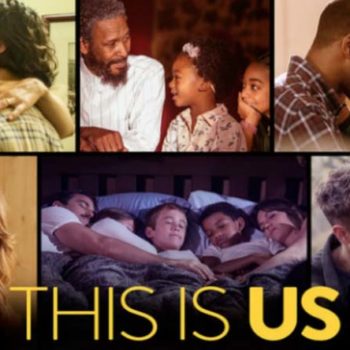Black Mirror: Grief Meets Robot Clones. Seriously.
/ Books, Movies, and Music : Litsa Williams
If you haven’t heard of Black Mirror, there's a good chance you will soon. It isn’t a new show. It actually first came out a couple years back in the UK and has just recently made it across the pond thanks to Netflix. After a friend recommended it to me a few months back, I've heard more and more people talking about it.
I'm afraid it's a hard show to quickly sum up, as each episode stands alone à la Twilight Zone style. There are no recurring characters or connected narratives. The general theme that underpins the show circles around the potential consequences of modern technology. It is dark to say the least, but incredibly compelling.
Anyway! You're probably wondering what this has to do with grief. Enter Season 2, Episode 1: Black Mirror Be Right Back. I shouldn’t have been surprised to find a grief-y episode because, once you’re looking for it, grief pops up everywhere. But I have to say, the intensity of this episode and the disturbing-yet-intriguing plot of the show was a bit overwhelming.
Here is where I disclose, this post is FULL OF SPOILERS. Not just little spoilers, but I-plan-to-share-the-entire-plot spoilers. If that concerns you, watch the show on Netflix and then come back. We’ll be right here waiting. Promise.
Okay, you’re back. Or you don’t care about spoilers and you never left. Let’s set the stage. The episode opens with a lovely couple, early-30s maybe, moving into the boyfriend/fiancé’s family home and being all sorts of cute. Banter, singing in the car, couple annoyances. You know the recipe. It is the future, but not far in the future. Feels like it could be 2015, but with nicer, slimmer cell phones and fancier computers. Our characters, the adorable couple, are Martha and Ash. Ash is constantly on his phone, yet remains remarkably endearing, and is played by one of the Weasley brothers from Harry Potter to boot!
They are just going along, settling into life, when Ash unexpectedly dies. We never know exactly how, but it seems safe to assume it was a car accident. The funeral happens, Martha returns to an empty home, and is... alone. Two thumbs up to Hayley Atwell, the actress who plays Martha. Her grief doesn’t feel overdone or forced. You feel her loneliness. In just minutes, she captures the moments after a death when everything seems surreal - when you feel outside yourself and like maybe you will just wake up and find this was a terrible nightmare. She conveys the experience of empty time and feeling directionless while keeping busy, all without a word.
Here is where Be Right Back takes a turn. A totally unrealistic yet terrifyingly possible turn. Martha has a widowed friend who, against Martha’s wishes, signs her up for something that ‘really helped’ in her grief. A therapist? A support group? A message board? A grief blog? Not so much. A new program that is ‘still in beta’ that takes every online communication from the person who died – the tweets, posts, photos, videos, emails, voicemails – and allows you a way to communicate with a program that simulates the person. When she receives the first email coming from “Ashm” she is horrified and irate. But her friend assures her it helps and that the more the system has, the more it will be ‘like him’.
Despite her disgust and initial resistance, you can probably see where this is going. Ash was an internet addict, the program would have a tremendous amount to work with. In her isolation and yearning, it immediately seems plausible that her horror may turn to curiosity or desperation. The next thing we learn is that Martha is pregnant and her pain and isolation intensifies. Before you know it, she is online starting a chat with “Ash” to tell “him” she is pregnant.
Okay, time out from the show. It just so happened that earlier the same day, before watching Black Mirror, I heard a RadioLab episode on NPR called “Talking to Machines”. You can listen to it here, or just read the synopsis:
We begin with a love story--from a man who unwittingly fell in love with a chatbot on an online dating site. Then, we encounter a robot therapist whose inventor became so unnerved by its success that he pulled the plug. And we talk to the man who coded Cleverbot, a software program that learns from every new line of conversation it receives...and that's chatting with more than 3 million humans each month. Then, five intrepid kids help us test a hypothesis about a toy designed to push our buttons, and play on our human empathy. And we meet a robot built to be so sentient that its creators hope it will one day have a consciousness, and a life, all its own.
Now, I have talked to Cleverbot and it certainly doesn’t make me feel like we are close to computer programs that mimic humans. That doesn’t change the fact that Cleverbot is kind of addictive for a little while, albeit totally frustrating. Humans talking to computer programs... not even close to impossible.
Okay, back to the show. Before you know it, Martha is chatting with “Ash” on the phone. A lot. Computer program “Ash” doesn’t always get Ash right, but a lot of the time he does. And as you watch Martha and “Ash” talk, it is creepy... but the griever in you sees the appeal. It isn’t Ash, but it can do a pretty good job guessing what Ash would say, and saying it in Ash’s voice, and there is something comforting there. Creepy, but comforting.
Soon “Ash” tells Martha that there is a next level to the program available and, he won’t lie, “it’s not cheap”. Next thing you know, an “Ash” robot-clone arrives at her home. Robot doesn’t even seem like the right word because it looks just like Ash – soft skin, the same hair, the same moles. He looks like Ash, only a little better, maybe because “the photos we keep tend to be flattering” and those are what created “Ash” - his online persona. This “Ash” now seems even more real that the e-chats and phone calls, yet Martha (and we) seem to become even more acutely aware of his limitations. He looks the part, he sounds the part, but something is missing. He doesn’t know how to argue, his reactions are just a little off, he doesn’t always feel the things that Ash would have felt.
Timeout, again. It is hard not to think about our internet presence when watching the episode. If our social media profiles could be made into a version of us, how accurate would it be? We often memorialize social media pages of people who died and we interact by posting on their page, sharing messages and comments both public and private. If Martha’s situation were real, which tragically it is for some, we can easily imagine a therapist encouraging her to write a letter to Ash about the pregnancy, sharing the things she needed to share. These things all seem reasonable, which begs the question, where is the line?
And as crazy as the idea of a robot version of our loved ones may seem on the surface, it doesn’t seem a far leap from the “reborn dolls” phenomenon. If you don’t know about these little guys, they are perfectly lifelike dolls that sell for hundreds (if not thousands) of dollars. There is an ever-increasing market for these dolls from grieving mothers, making it hard not to wonder: If technology continues to develop, why would this not progress to full-on robots? Don’t know about reborn dolls? Don’t worry, your can check out an article about them here. Intrigued? You can check out a 28 minute documentary about the phenomenon here.
Okay, back to Black Mirror. As the show moves on, Martha becomes more and more frustrated that “Ash” is not Ash. What filled a void on the surface doesn’t have the depth to truly fill the void of her loss. “Ash” is not Ash, he will never be Ash. The end is worth a watch, so I won’t spoil it here (but, if you’re desperate to know and don’t want to watch, luckily Wikipedia comes through again with a full episode synopsis). There is something creepy and painful and disturbing about the ending, but it fits. Because, let’s be honest, it is a creepy and painful and disturbing idea that doesn’t feel quite as far off as we want it to be. It only seems appropriate we should be left feeling a bit unsettled.
This episode of Black Mirror could be written off as totally crazy until we remember that grief can be totally crazy. It makes us do crazy things, things we could never imagine. Technology is both amazing and frightening and this episode takes all of those realities and smashes them into one story. People take advantage of grievers all too often, preying on their pain and hurt. If the technology was there, it doesn't seem impossible that someone would try to tap that market. Especially now that Black Mirror has planted the idea!
So, no lesson learned today. No coping skills or journal prompts. Just a really weird, grief-y show that got me thinking more than I expected. Thanks Black Mirror.
Hoping I am not the only one who has watched Black Mirror. Leave a comment and let us know what you thought!
We wrote a book!
After writing online articles for What’s Your Grief
for over a decade, we finally wrote a tangible,
real-life book!
What’s Your Grief? Lists to Help you Through Any Loss is for people experiencing any type of loss. This book discusses some of the most common grief experiences and breaks down psychological concepts to help you understand your thoughts and emotions. It also shares useful coping tools, and helps the reader reflect on their unique relationship with grief and loss.
You can find What’s Your Grief? Lists to Help you Through Any Loss wherever you buy books:





Erin January 6, 2019 at 5:27 am
This is one of my favorite episodes of Black Mirror and I think the reason it is so powerful is it’s intimate portrayal of grief. Like all of Black Mirror’s episodes, there is a surreal WTF element. But this one is very moving for me. She doesn’t just lose him when he dies – she experiences that loss again when she comes to terms with the fact that the replacement is at the end of the day, just not him. And the cliff scene is just heartbreaking.
Also, if anyone is interested in the idea of a profile or person being created based on our social media activity, check out the book ‘Inodoru’ by William Gibson
Kelly February 5, 2015 at 7:28 pm
Thanks for keeping me up to date. Cancelled my cable a while back and haven’t looked back, but realize that I am out of the loop. I really appreciate your getting the heads-up out there on things that have really interested me. I just read “Wild” and watched the episode of “Black Mirror.”
The “Black Mirror” episode was kind of creepy, but I’m embarrassed to admit, I might have been lured by an opportunity for a simulated chat. I’d draw the line, however, with a clone. It struck me what it is that animates us, what it is that makes us who we are. I think that is the thing you notice at funerals, a body becomes so disconnected without the personality that animated it, totally separate. There is no , no substitution that could ever possibly replace one who is gone.
The other thing that really made an impression with me is the normal imperfection of relationships. I go through regular bouts of guilt around not being the perfect wife or daughter and have tried to tell myself that the closest relationships are the ones where we slip up, where we are ourselves and that no relationship is perfect. The clone was incapable of engaging in the natural conflict that any human beings who are close might encounter. It made me feel better to see what a totally compliant relationship might look like and to appreciate the depth of the relationships that I’ve had that sometimes included not being pleasing one hundred percent of the time.
D. Johnson February 5, 2015 at 7:07 pm
As someone who has tried many substitutes for people I’ve lost, they just don’t work and the grief and loneliness intensify instead. I’ll have to check this movie out.
Felicia February 5, 2015 at 4:44 pm
I too have discovered this series and have seen this episode. They are all wonderfully done and yes, creepy. I found myself wanting an “Ash” at first but quickly realized nothing could replace my husband of 22 years.
Susy February 5, 2015 at 3:19 pm
I agree with Doris, and feel a little frightened at the idea of this taking hold someday, and not in the too distant future. Intriguing, creepy, yes. . . but the gist is, as Doris said, remaining stuck in one place in your grief . . . and never moving through the entire journey just isn’t healthy. This would end up being a HUGE bonus for therapists. . . and then it would move to the Isaac Asimov Robotic theory issues, is a robot sentient, how do you turn it off? Would this create a whole new aspect of law.
Doris February 5, 2015 at 1:04 pm
Interesting episode; sort of a “beware what you wish for” story… It would have been less disturbing had it ended on the cliff scene. Having lost my husband far too soon, in March 2014, I have wished to be able to talk to him, to be held by him, to have him back. There isn’t much of him on social media, so his “telephone persona” and his “robot” would never get close to the real him. If this technology were really possible, I certainly understand the appeal of using it, especially in those deepest, darkest months of grief. But, what I take from the ending of this episode, is that Martha is now trapped in her grief, because “Ash” is with her forever, she is stuck with an Ash that cannot feel, will never age, will never grow and change emotionally… How terrible to be stuck in a particular moment of your grief and never heal fully.
Bob February 5, 2015 at 12:30 pm
Grief in the age of electronics and AI. Wow.
You are right. Grief can be totally crazy. That said, there is an idiosyncratic logic of its own. It seems crazy from the outside, but from the inside it seems consistent.
There are websites where a person can create memorial for loved ones. If nothing else you can set up a Facebook Album about the deceased.
Since my son’s death (He was 21 yrs at his passing) I find I play a lot of video games. Not the shoot-em-ups or the gory stuff — more like the Prof. Layton series on an old Nintendo DS I used to use in the hospital to pass the time when Mike was asleep. One online game has earned my respect because 1) it is a very safe environment — the mediators watch it like a hawk for predators and inappropriate behavior; and 2) it is turn based and can be controlled using only one hand which would make it ideal for a physically challenged individual. One part of the game is the ability to buy “castles”. A castle is a home/retreat your character can go to to store equipment. Even more, you can furnish and decorate it like a home (beds, wall paper, flooring, art, etc), plant gardens and tend plants, you can even invite others to visit you at the castle to show off your home or play special mini-games (“gauntlets”) which can be purchased for your home.
So far just childish. This is the crazy part. In the last castle/home I got there are a lot of grottos. I converted one of the grottos into a gravesite for my son. The game does have two styles of headstones — I chose the Asian memorial tablet style. I also surrounded the grave with various animals (Mike loved animals) and decorations I think he would have appreciated. (There is a praying mantis pillar.Mike loved insects mantises most of all.) I can now go visit the graveside when I play the game. Its not the same as going to the real-world graveside, but it is a much shorter drive. I can have the same mental conversations at the virtual graveside as I have at the actual graveside. I can even place flowers — and those won’t get collected and thrown away after a week. After I have visited the virtual graveside, I can return to the game and fight some monsters or join some friends on a quest.
Crazy? Pathetic? Morbid? I do not know. It seems to fill a gap right now and I am not sure it needs defending or explaining. I just thought I’d share.
Lorie February 5, 2015 at 11:52 am
I wish I hadn’t watched that. I feel awful.
Jayne Flaagan February 5, 2015 at 11:11 am
My sister made hand casts of my mom, brother and her husband after they died and has them on a table that looks like a shrine. I thinks it’s totally weird, but somehow it must comfort her…
Lisa Bogatin February 5, 2015 at 10:58 am
HI Litsa,
Thank you for your posts that never let you down.
Interesting and thought provoking!
It sounds like a Mitch Albom book.
Equally thought provoking….and creepy, there is a website called:
DNA2Diamonds.com
You can make a piece of jewelry out of your deceased loved one (or pet)!
I asked my husband if he wants to be a necklace or a pair of earrings.
It’s bizarre, but it’s true.